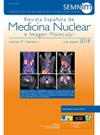Comparación de los rendimientos diagnósticos de la gammagrafía de perfusión miocárdica SPECT corregida por atenuación por TC y corregida sin atenuación en la enfermedad de las arterias coronarias
IF 1.6
4区 医学
Q3 RADIOLOGY, NUCLEAR MEDICINE & MEDICAL IMAGING
Revista Espanola De Medicina Nuclear E Imagen Molecular
Pub Date : 2025-02-12
DOI:10.1016/j.remn.2024.500085
引用次数: 0
Abstract
Introduction and objectives
Tissue attenuation reduces the specificity of the myocardial perfusion imaging single photon emission tomography (SPECT), which leads reduced diagnostic accuracy. The aim of this study is to compare performances of non-attenuation corrected (NAC), computed tomography based-attenuation corrected (AC) and prone images for qualitative and semi-quantitative analysis of myocardial perfusion SPECT in diagnosis of coronary artery disease (CAD).
Materials and methods
Eighty six patients in whom NAC, AC and prone images were obtained with SPECT, and whose coronary angiography/CT coronary angiography was completed within 3 months, were retrospectively studied. Myocardial perfusion scintigraphy was performed using SPECT/CT dual-headed gamma camera. Images were evaluated qualitatively and semi-quantitatively using 20-segment model. Analyzes of global myocardium and LAD, RCA, Cx vascular areas as regional analysis were performed. In qualitative evaluation, if SPECT study was abnormal, relevant coronary artery area was recorded. Quantitative Perfusion SPECT (QPS) program was used in semi-quantitative analysis; Summed Stress Score (SSS) ≥ 4 was accepted for presence of CAD in per-patient analysis. In regional analysis SSS ≥ 2 was taken into account. Coronary angiography/CT coronary angiography was used as gold standard. Threshold value was determined as ≥ 50% and above luminal diameter narrowing. While AC and NAC methods were compared for per-patient analysis and each vascular area; 3 imaging methods including prone acquisition, were compared for the RCA area. Diagnostic performances of the methods were evaluated by comparing the areas under the curve with ROC analysis.
Results
In visual evaluation, sensitivity of AC was significantly lower than NAC in analyzes of per-patient, RCA and Cx areas (global 76.92% vs 86.15%, RCA 60.87% vs 82.61%, Cx 58.97% vs 69.23%, respectively; P < .05). Sensitivity of prone imaging was significantly higher than AC in analysis of the RCA area (76.09% vs 60.87%, respectively; P < .05) Specificity values were higher in analyzes of global, RCA and Cx areas in AC than in NAC method; this difference was significant in RCA and Cx areas (RCA 70% vs 42.50%, Cx 85.11% vs 70.21%, respectively; P < .05). In semi-quantitative evaluation, AC and NAC had similar sensitivity and specificity in global and regional analyzes; in RCA area, no significant difference was detected between the 3 methods. In ROC analysis, no significant difference was detected between methods in per-patient and regional analyzes both in visual and semi-quantitative evaluation.
Conclusions
CT-based attenuation correction increases specificity, but reduces sensitivity in the diagnosis of CAD in regional areas of RCA and Cx. Prone imaging remains important in evaluation of RCA area.
在冠状动脉疾病中,经CT衰减校正和非衰减校正的SPECT心肌灌注造影术的诊断结果比较
问题衰减降低了心肌灌注成像单光子发射断层扫描(SPECT)的特异性,导致诊断准确性降低。本研究的目的是比较非衰减校正(NAC)、基于计算机断层扫描的衰减校正(AC)和倾向图像在定性和半定量分析心肌灌注SPECT诊断冠状动脉疾病(CAD)中的表现。材料与方法回顾性分析66例在3个月内完成冠状动脉造影/CT冠状动脉造影并经SPECT获得NAC、AC及俯卧位图像的患者。采用SPECT/CT双头伽马照相机进行心肌灌注显像。采用20段模型对图像进行定性和半定量评价。局部分析整体心肌及LAD、RCA、Cx血管区。定性评价时,如SPECT显像异常,记录相关冠状动脉面积。半定量分析采用定量灌注SPECT (QPS)程序;在每例患者分析中,接受压力总分(SSS)≥4作为存在CAD的标准。在区域分析中,考虑SSS≥2。冠状动脉造影/CT冠状动脉造影为金标准。阈值确定为≥50%及以上的管腔直径变窄。而AC和NAC方法在每个患者和每个血管区域的分析比较;比较了包括俯卧采集在内的3种成像方法对RCA区域的成像效果。通过曲线下面积与ROC分析的比较,评价各方法的诊断效果。结果在目视评价中,AC对单个患者、RCA和Cx区域的敏感性显著低于NAC (global 76.92% vs 86.15%, RCA 60.87% vs 82.61%, Cx 58.97% vs 69.23%);P & lt;. 05)。俯卧位成像对RCA区域的敏感度显著高于AC(分别为76.09%和60.87%);P & lt;0.05) AC法的全局、RCA和Cx区特异性值高于NAC法;RCA和Cx区差异显著(RCA分别为70% vs 42.50%, Cx为85.11% vs 70.21%;P & lt;. 05)。在半定量评价中,AC和NAC在全局和区域分析中具有相似的敏感性和特异性;在RCA区,3种方法间差异无统计学意义。在ROC分析中,在目测和半定量评估中,个体分析和区域分析的方法没有发现显著差异。结论基于ct的衰减校正增加了特异性,但降低了RCA和Cx局部区域诊断CAD的敏感性。俯卧位成像仍然是评估RCA区域的重要手段。
本文章由计算机程序翻译,如有差异,请以英文原文为准。
求助全文
约1分钟内获得全文
求助全文
来源期刊

Revista Espanola De Medicina Nuclear E Imagen Molecular
RADIOLOGY, NUCLEAR MEDICINE & MEDICAL IMAGING-
CiteScore
1.10
自引率
16.70%
发文量
85
审稿时长
24 days
期刊介绍:
The Revista Española de Medicina Nuclear e Imagen Molecular (Spanish Journal of Nuclear Medicine and Molecular Imaging), was founded in 1982, and is the official journal of the Spanish Society of Nuclear Medicine and Molecular Imaging, which has more than 700 members.
The Journal, which publishes 6 regular issues per year, has the promotion of research and continuing education in all fields of Nuclear Medicine as its main aim. For this, its principal sections are Originals, Clinical Notes, Images of Interest, and Special Collaboration articles.
 求助内容:
求助内容: 应助结果提醒方式:
应助结果提醒方式:


